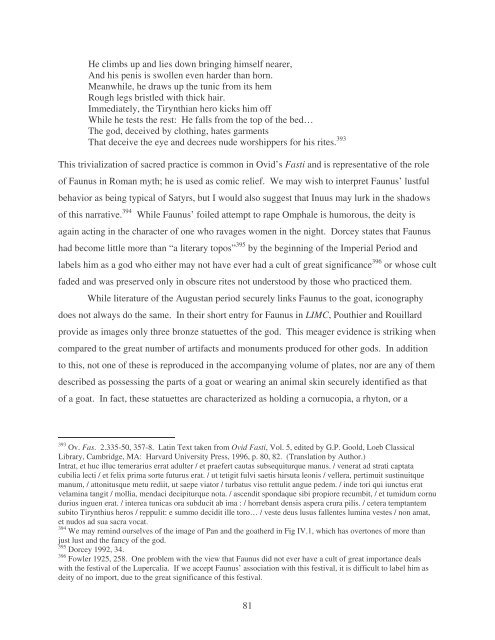Final Draft - Preview Matter - Florida State University
Final Draft - Preview Matter - Florida State University
Final Draft - Preview Matter - Florida State University
You also want an ePaper? Increase the reach of your titles
YUMPU automatically turns print PDFs into web optimized ePapers that Google loves.
He climbs up and lies down bringing himself nearer,<br />
And his penis is swollen even harder than horn.<br />
Meanwhile, he draws up the tunic from its hem<br />
Rough legs bristled with thick hair.<br />
Immediately, the Tirynthian hero kicks him off<br />
While he tests the rest: He falls from the top of the bed…<br />
The god, deceived by clothing, hates garments<br />
That deceive the eye and decrees nude worshippers for his rites. 393<br />
This trivialization of sacred practice is common in Ovid’s Fasti and is representative of the role<br />
of Faunus in Roman myth; he is used as comic relief. We may wish to interpret Faunus’ lustful<br />
behavior as being typical of Satyrs, but I would also suggest that Inuus may lurk in the shadows<br />
of this narrative. 394 While Faunus’ foiled attempt to rape Omphale is humorous, the deity is<br />
again acting in the character of one who ravages women in the night. Dorcey states that Faunus<br />
had become little more than “a literary topos” 395 by the beginning of the Imperial Period and<br />
labels him as a god who either may not have ever had a cult of great significance 396 or whose cult<br />
faded and was preserved only in obscure rites not understood by those who practiced them.<br />
While literature of the Augustan period securely links Faunus to the goat, iconography<br />
does not always do the same. In their short entry for Faunus in LIMC, Pouthier and Rouillard<br />
provide as images only three bronze statuettes of the god. This meager evidence is striking when<br />
compared to the great number of artifacts and monuments produced for other gods. In addition<br />
to this, not one of these is reproduced in the accompanying volume of plates, nor are any of them<br />
described as possessing the parts of a goat or wearing an animal skin securely identified as that<br />
of a goat. In fact, these statuettes are characterized as holding a cornucopia, a rhyton, or a<br />
393<br />
Ov. Fas. 2.335-50, 357-8. Latin Text taken from Ovid Fasti, Vol. 5, edited by G.P. Goold, Loeb Classical<br />
Library, Cambridge, MA: Harvard <strong>University</strong> Press, 1996, p. 80, 82. (Translation by Author.)<br />
Intrat, et huc illuc temerarius errat adulter / et praefert cautas subsequiturque manus. / venerat ad strati captata<br />
cubilia lecti / et felix prima sorte futurus erat. / ut tetigit fulvi saetis hirsuta leonis / vellera, pertimuit sustinuitque<br />
manum, / attonitusque metu rediit, ut saepe viator / turbatus viso rettulit angue pedem. / inde tori qui iunctus erat<br />
velamina tangit / mollia, mendaci decipiturque nota. / ascendit spondaque sibi propiore recumbit, / et tumidum cornu<br />
durius inguen erat. / interea tunicas ora subducit ab ima : / horrebant densis aspera crura pilis. / cetera temptantem<br />
subito Tirynthius heros / reppulit: e summo decidit ille toro… / veste deus lusus fallentes lumina vestes / non amat,<br />
et nudos ad sua sacra vocat.<br />
394<br />
We may remind ourselves of the image of Pan and the goatherd in Fig IV.1, which has overtones of more than<br />
just lust and the fancy of the god.<br />
395<br />
Dorcey 1992, 34.<br />
396<br />
Fowler 1925, 258. One problem with the view that Faunus did not ever have a cult of great importance deals<br />
with the festival of the Lupercalia. If we accept Faunus’ association with this festival, it is difficult to label him as<br />
deity of no import, due to the great significance of this festival.<br />
81

















